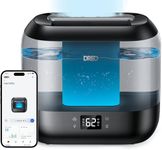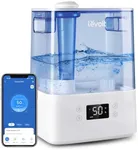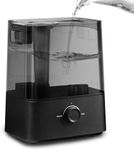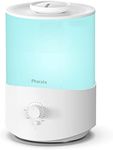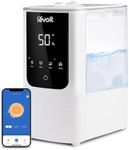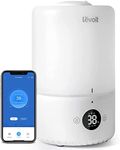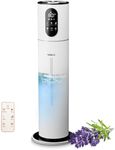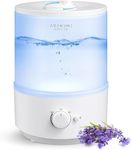Buying Guide for the Best Humidifier For Plants
Choosing a humidifier for your plants is all about creating the right environment for them to thrive. Plants, especially tropical varieties, often need higher humidity than what is naturally present in most homes. A good humidifier can help maintain consistent moisture in the air, which supports healthy growth, prevents leaf browning, and reduces plant stress. When shopping for a humidifier, it's important to consider the size of your plant area, the type of mist produced, how easy it is to clean, and how much control you have over humidity levels. Understanding the key features will help you pick a model that matches your plant collection and care routine.Tank CapacityTank capacity refers to how much water the humidifier can hold at one time. This is important because it determines how long the humidifier can run before needing a refill. Smaller tanks (under 1 liter) are suitable for a few plants or small spaces, but they require frequent refilling. Medium tanks (1-3 liters) are good for a moderate number of plants or a small room, offering a balance between size and convenience. Large tanks (over 3 liters) are best for bigger plant collections or larger rooms, as they can run for many hours or even days without refilling. To choose the right size, consider how many plants you have and how much time you want to spend maintaining the humidifier.
Mist Output TypeMist output type describes whether the humidifier produces cool mist, warm mist, or both. Cool mist humidifiers are common and safe for most plants, as they gently increase humidity without raising the temperature. Warm mist models heat the water before releasing it, which can slightly warm the air and may help reduce bacteria, but they use more energy. Some humidifiers offer both options. For most plant owners, a cool mist is sufficient and energy-efficient, but if you have sensitive tropical plants or want to avoid bacteria, a warm mist option might be helpful.
Coverage AreaCoverage area tells you how much space the humidifier can effectively humidify, usually measured in square feet or meters. Small units cover up to 100 square feet, which is enough for a tabletop or a small plant shelf. Medium units cover 100-300 square feet, suitable for a small room or a larger plant corner. Large units can cover over 300 square feet, ideal for big rooms or greenhouses. To pick the right one, measure the area where your plants are and choose a humidifier that matches or slightly exceeds that size.
Adjustable Humidity SettingsAdjustable humidity settings let you control how much moisture the humidifier adds to the air. Some models have simple low, medium, and high settings, while others allow you to set a specific humidity percentage. This feature is important because different plants have different humidity needs, and too much humidity can cause mold or mildew. If you have a variety of plants or want precise control, look for a model with adjustable or automatic humidity controls. If your needs are simple, basic settings may be enough.
Ease of CleaningEase of cleaning refers to how simple it is to take apart and clean the humidifier. Regular cleaning is important to prevent mold, bacteria, and mineral buildup, which can harm your plants and your health. Some humidifiers have wide openings and fewer parts, making them easier to clean, while others may have small crevices that are harder to reach. If you want to spend less time on maintenance, look for a model that is designed for easy cleaning and has dishwasher-safe parts if possible.
Noise LevelNoise level indicates how loud the humidifier is when running. Some models are very quiet and suitable for bedrooms or living spaces, while others may produce a noticeable hum or bubbling sound. If your plants are in a quiet area or you are sensitive to noise, look for a humidifier labeled as 'ultra-quiet' or check the decibel rating. For plant rooms or areas where noise is not a concern, this may be less important.

